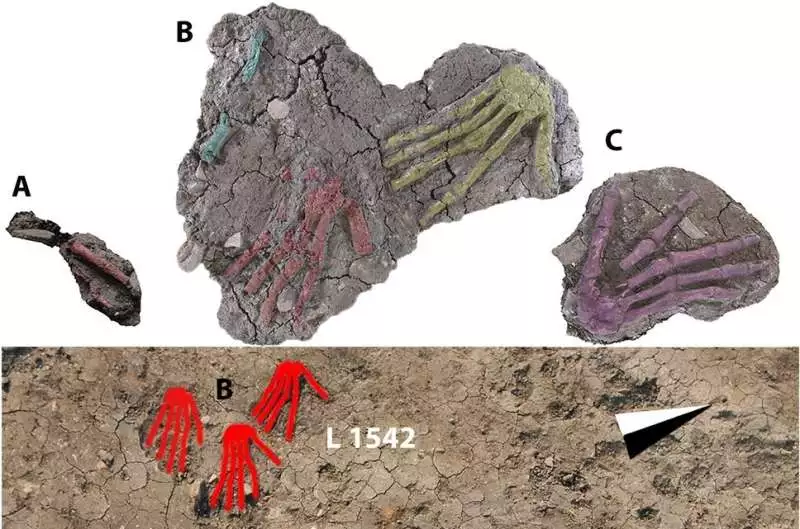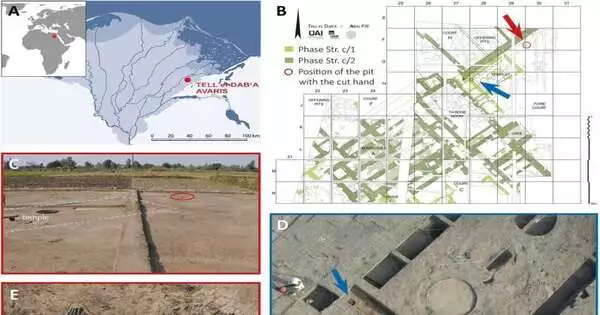Researchers from the German Archaeological Institute in Berlin, under the direction of Julia Gresky, have examined 12 to 18 right hands that were found buried in pits in an ancient Egyptian palace. This is the first physical proof of a practice that was previously only known from iconographic and literary sources.
In their paper titled “First osteological evidence of severed hands in Ancient Egypt,” which was published in the journal Scientific Reports, the researchers describe the grisly discovery in detail and speculate as to why twelve hands were deposited in this manner. In the forecourt of the Hyksos palace in Avaris, northeastern Egypt, the excavation site where the hands were found dates to roughly 1640–1530 BC.
The Hyksos kings were probably members of the local populace with close ties to western Asia or the Levant. At the time, Egypt’s central power was waning, but it would soon recover thanks to an influx of technology from its multicultural immigrant population, including the horse and chariot.
In what would have been the palace’s entrance court, in front of the throne room, the hands were discovered in three different pits. The severed hands were probably positioned there with the intention of being seen, and they would have been a striking sight. The sight of so many severed hands certainly changed the visitor’s perspective on whatever business they may have had with the king.
Given that the hands were not all completely intact and that they were buried together, the researchers had to use a technique that is common in mixed grave sites to determine the minimum and maximum number of people needed to make up the remains. It was discovered that the minimum range was 12 and the maximum range was 18.

Anthropological reconstruction of the discovery and information about the right hands of Pits L1542, L1543 (reconstruction and pictures of individual hands, J. Gresky): Reconstruction of the entire hands in Pits L1542 (left upper corner) and L1543 (lower half of the image). While red hands are placed on their palmar surface, yellow hands are placed on their dorsal surface. Reconstruction is done to fill in the gaps. Eight right hands from Pit L1543, along with single phalanges that may or may not be associated with the current hands, are shown in Figures A, C, and F. Bones that have been preserved have color. (B) In Pit L1542, three right hands with their palmar surfaces exposed The preserved bones are colored. Credit: Scientific Reports (2023). DOI: 10.1038/s41598-023-32165-8
Due to the lack of age- or sex-dependent features compared to, say, a pelvis or skull, hands can be challenging to evaluate forensically. As the bones were fully formed after adolescence, the minimum ages for the hands were set at 14 to 21 years. The maximum age range was below 60, with no evidence of age-related degeneration.
The researchers used the robustness of the bones and a morphological tendency for male index fingers to be longer than their ring fingers to determine gender. With the exception of the 12th hand, which was left unidentified, 11 of the hands were found to be male. The authors speculate that even though it is unknown, the 12th hand might be female because, at the time in Egypt, women were not well protected from the dangers of war or conflict.
When the hands were acquired—from deceased or living people—is a little bit of a mystery. Regardless, the researchers found that “. When they were dropped into the pit, the hands must have been supple and flexible. The analysis concludes that the hands found their way to the pits between 24 and 48 hours after collection, which is the most likely scenario. It can be inferred from this that at least a day passed between the amputation and placement in the palace.
The absence of any indication that the forearms to which the hands were once attached exist is another intriguing aspect. In order to display only the anatomical hands, it appears that great care was taken to remove all traces of the appendage. However, it is impossible to tell if the hands were removed neatly from the arms or if the removal process left some mess.
The practice of hand severing does appear in iconographic accounts from 50 to 80 years after the pits, despite the fact that there is little evidence of it before that time. If this is the cause of the activity in Egypt, the authors contend that it might have its roots in the same societies where the Hyksos leadership first emerged. The practice might have spread as the cultures mingled.
Taking a hand from an enemy became a custom in warfare in the dynasties that followed, despite the fact that the Hyksos Avaris hands may have been used in a ceremony at the palace. The discovery of tangible proof of the practice has not previously been reported.
More information: Julia Gresky et al, First osteological evidence of severed hands in Ancient Egypt, Scientific Reports (2023). DOI: 10.1038/s41598-023-32165-8





